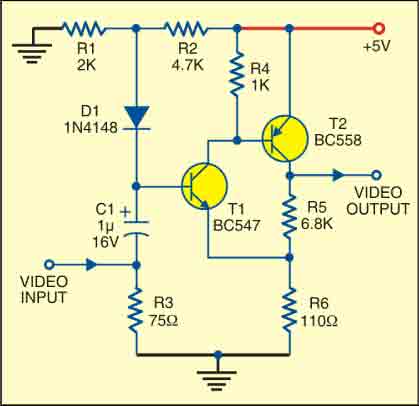 There are times when you want to view the video clips taken by your camera on your TV. You can do so by interfacing the video output of the source device (camera) to the video input terminals of the TV. However, at times the video signal level needs to be raised before it is fed to the TV. Presented here is a simple video amplifier to take care of your problems.
There are times when you want to view the video clips taken by your camera on your TV. You can do so by interfacing the video output of the source device (camera) to the video input terminals of the TV. However, at times the video signal level needs to be raised before it is fed to the TV. Presented here is a simple video amplifier to take care of your problems.

A PAL video amplifier is expected to have a 3dB bandwidth of 5.5 MHz. The waveform levels of a 1VPk-Pk PAL video signal between any two line sync pulses (separation 64 Us) are shown in Fig. 1. The waveform shows that each scan line lasts 64 µs, of which only 52 Uscontains active video or picture data. The video level (variable) lies between 0V and 0.7V and the blanking level extends from 0V down to –0.3V (for 12 Us). The black level or blanking level starts at 0V, the white level or peak video level is 0.7V and the sync pulse peak (-ve) level is –0.3V.
Normally, the video amplifier section for TV requires low and high voltage level stages. Fig. 2 shows a typical low-level transistorised video amplifier stage that accepts 1VPk-Pk and outputs 2VPk-Pk signal. (The circuit has been tested at 4.7 MHz.) This low-level stage requires a single 5V DC supply.
A simple video amplifier circuit
The R1-R2 divider network adjusts the DC level of the video, while the R5-R6 divider network adjusts the gain. You may replace both the dividers with two 4.7-kilo-ohm (or 5-kilo-ohm) trimpots for proper adjustment of the DC level and the gain. The 75-ohm resistor (R3) may be discarded if you feed the video from a high-output-impedance stage.
Although the resistive load in the collector of the transistor provides reasonably good bandwidth, a peaking coil of 20 to 30 uH can be added in series with R4 to improve its performance at higher frequencies. With 1VPk-Pk signal as the input, the given circuit outputs 3.5VPk-Pk maximum amplitude at 6.25 MHz without the peaking coil.

The article was originally updated in April 2010 and has been recently updated.








very clear notes, thankyou so much. its really helped me understand the circuit for my college assignment.